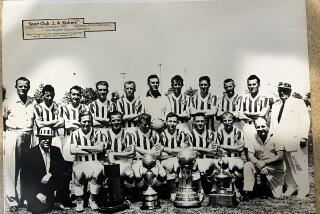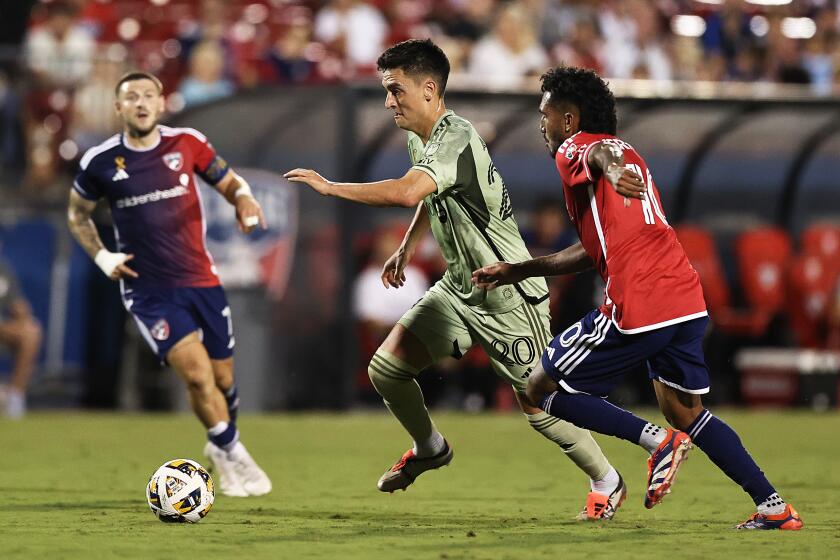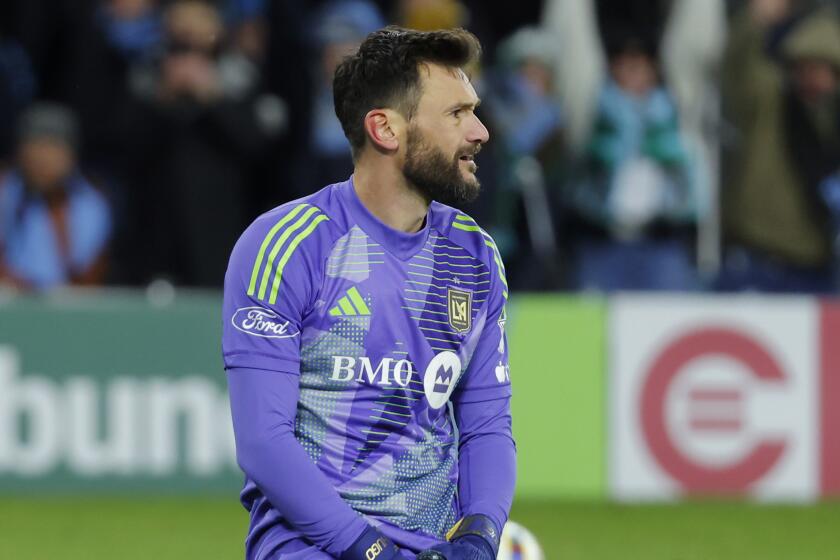Neutral Zone Is No Place for New U.S. Soccer Boss
The holy Hindu city of Allahabad, India, and the some-might-say unholy city of Las Vegas are about as far apart as two places can be -- geographically, economically, culturally and, most obvious of all, morally.
It is quite a journey, then, that Sunil Gulati has traveled, all the way from his birthplace in the Indian state of Uttar Pradesh to the American state of utter abandon where, Saturday at the Flamingo Hotel on the Vegas Strip, he was elected president of U.S. Soccer.
For Gulati, a 46-year-old economics teacher at Columbia University, it marked the culmination of a quest that has taken the better part of a quarter of a century.
There is hardly a position in soccer in this country that Gulati has not held. He was involved in the U.S. acquiring the 1994 World Cup and then in running it. He was deputy commissioner of Major League Soccer for its first three years. He was on the board of the 1999 and 2003 Women’s World Cup tournaments.
The list goes on.
He has been executive vice president of U.S. Soccer since 2000, until rising to the top spot Saturday and replacing Dr. S. Robert Contiguglia, the Denver kidney specialist who had served two four-year terms. Gulati’s election was by unanimous consent.
He serves on a number of FIFA and CONCACAF committees. He is president of Kraft Soccer Properties, owner of the New England Revolution. He is on the board of the U.S. Soccer Foundation and the National Soccer Hall of Fame.
Suffice to say that Gulati has no learning curve ahead of him.
And even if he did, he would probably ace the tests. He did, after all, graduate magna cum laude from Bucknell before earning two master’s degrees at Columbia and later served a stint at the World Bank.
In short, the man is no dummy, which is why, in this corner of the world at least, much is expected of him.
The U.S. federation has been loath to speak out on controversial issues in the past. It has meekly accepted all the corruption that infests FIFA and CONCACAF, soccer’s North and Central American and Caribbean region.
But if the U.S. is to be taken seriously in international soccer circles, it has to do more than simply win a few games on the playing field. Its voice must be heard. It must speak out, it must lead, it must condemn the unethical and the unscrupulous who are filling their pockets at the expense of the sport.
It must provide the moral leadership so sadly lacking in the upper reaches of the sport’s administration.
And if that means crossing swords with the likes of FIFA President Joseph “Sepp” Blatter and CONCACAF President Jack Warner, then so be it.
Gulati has the opportunity now to set a new course. This is no time to be neutral.
He is either from Allahabad or Las Vegas.
Which is it to be?
*
No sooner had MLS resolved its naming controversy in Texas, where the Clash-Earthquakes-1836-Dynamo will open play in Houston this season, than another one erupted in New Jersey.
Red Bull New York is the new name of the MetroStars, after their purchase last week by Austrian energy drink magnate Dieter Mateschitz. But some folks in New Jersey don’t like that name. Something about New York sets their teeth on edge.
Politicians have protested, and George Zoffinger, the president and chief executive officer of the New Jersey Sports and Exposition Authority, wants Red Bull New York kicked out of Giants Stadium.
“They will not play in our stadium unless they have New Jersey in their name,” he said.
Happily, Red Bull New York will be out of the decrepit Meadowlands soon enough and in a real soccer stadium.
Red Bull Arena in Harrison, N.J., will open in 2008, and fans there surely will welcome the team no matter what its name.
*
The U.S. National Soccer Hall of Fame ballots arrived last week and, as always, the choices they present require some thought. Flinging darts at a list of names pinned to the wall doesn’t cut it.
There are 10 newcomers up for election to Oneonta -- which does not have quite the same ring as Cooperstown just yet but is actually just down the road from it.
The 10, in no particular order, are former U.S. women’s national team captain Carla Werden Overbeck, Jena Kluegel, Mikki Serlenga, Tisha Venturini-Hoch, Alexi Lalas, Mauricio Cienfuegos, Roy Lassiter, Mike Clark, Chad McCarty and Tom Presthus.
There also are 47 holdovers from the 2005 ballot, when Marcelo Balboa, John Harkes and Tab Ramos were inducted.
Only two players are elected each year, although a third can make it if he or she receives at least 80% of the votes.
That’s what makes it a tough choice in 2006. Overbeck, Lalas and Cienfuegos are obvious Hall of Fame players, but some others are in their final year of eligibility and it’s now or never -- although a veterans’ committee vote offers a small loophole to sneak in by later.
Those on the brink include Mary Harvey, the starting goalkeeper on the 1991 world championship-winning U.S. women’s team, as well as former men’s national team players Desmond Armstrong, Bruce Murray and Erich Eichmann, all from the 1990 World Cup squad, and Hugo Perez, who missed Italy ’90 only because of an injury.
For each of them, eligibility runs out this year.
But other names on the ballot are equally recognizable and deserving. Who would argue that Carlos Valderrama does not belong in the Hall of Fame? How about three former players who are now MLS coaches: Dominic Kinnear, Peter Nowak and Mo Johnston?
What about the likes of former U.S. internationals Thomas Dooley, Mike Burns, Wendy Gebauer, Peter Vermes, Perry Van der Beck, John Doyle, Frank Klopas, Janusz Michallik, Sara Whalen ... the list goes on and on.
The Hall of Fame inductees for 2006 will be announced April 22.






